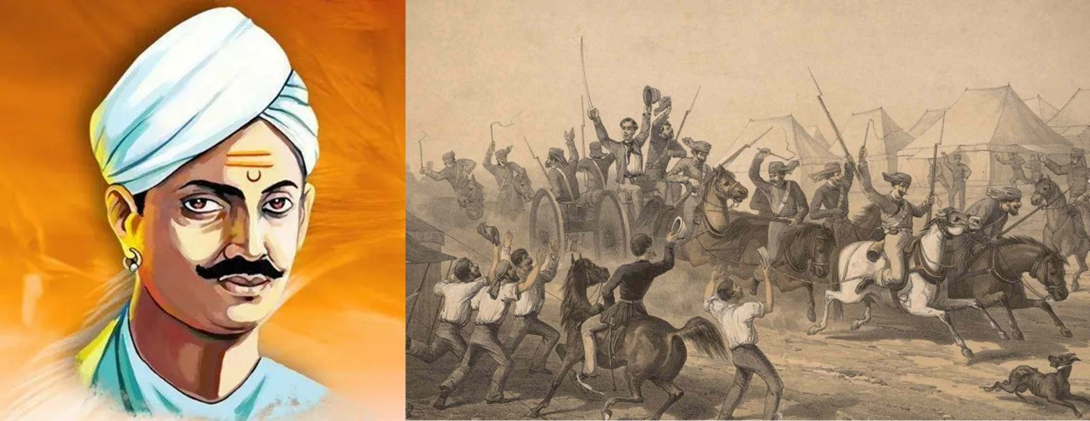- Courses
- GS Full Course 1 Year
- GS Full Course 2 Year
- GS Full Course 3 Year
- GS Full Course Till Selection
- Answer Alpha: Mains 2025 Mentorship
- MEP (Mains Enrichment Programme) Data, Facts
- Essay Target – 150+ Marks
- Online Program
- GS Recorded Course
- Polity
- Geography
- Economy
- Ancient, Medieval and Art & Culture AMAC
- Modern India, Post Independence & World History
- Environment
- Governance
- Science & Technology
- International Relations and Internal Security
- Disaster Management
- Ethics
- NCERT Current Affairs
- Indian Society and Social Issue
- NCERT- Science and Technology
- NCERT - Geography
- NCERT - Ancient History
- NCERT- World History
- NCERT Modern History
- CSAT
- 5 LAYERED ARJUNA Mentorship
- Public Administration Optional
- ABOUT US
- OUR TOPPERS
- TEST SERIES
- FREE STUDY MATERIAL
- VIDEOS
- CONTACT US
REMEMBERING MANGAL PANDEY, AND THE LEGACY OF THE REVOLT HE INSPIRED
REMEMBERING MANGAL PANDEY, AND THE LEGACY OF THE REVOLT HE INSPIRED
08-04-2024

Mangal Pandey, a soldier in the British East India Company, was hanged on 8th April for revolting against the colonial rulers. On his death anniversary today, Mangal Pandey is being remembered for his great courage and sacrifice. Mangal Pandey led the Revolt of 1857, also known as the First War of Indian Independence. The Sepoy Mutiny was a turning point and historic moment in Indian history.
- The Rebellion of 1857 ended the rule of the East India Company over India, which would now rule in the name of the British King through the Secretary of State.
Background:
Sepoy Mangal Pandey had no idea that the bullet he fired at the Sergeant Major of his regiment at Barrackpore near Kolkata on March 29, 1857, would lead to a great event in the history of modern India: the Sepoy Mutiny of 1857 or the Mutiny or the First War of Indian Independence.
- With this, the rule of the East India Company over India ended, which would now rule in the name of the British King through the Secretary of State.
Mangal Pandey and the discontent of Awadh
- Mangal Pandey belonged to the state of Awadh, which was fraudulently captured by the British in 1856.
- The Begums of Awadh had an agreement with the British and were following the terms of the agreement, but despite this Awadh was captured, which spread anger among the people.
- Awadh supplied a large number of troops to the Company's army, which included 75,000 soldiers from Awadh and a representative from almost every farming family in the state.
- The confiscation of the Nawab's throne and the villages of the Talukdars during the Land Revenue Settlement of 1856 led to resentment.
- The sepoys submitted 14,000 petitions regarding the difficulties caused by the revenue system.
- Mangal Pandey represented the discontent brought upon peasant families by the misery of British rule.
The mutiny and hanging of Mangal Pandey
- Mangal Pandey was born on July 19, 1827, in Nagwa village in Batia district in a Bhumihar Brahmin family.
- He joined the East India Company's army at the age of 22 as a soldier in the 6th company of the 34th Bengal Native Infantry.
- He refused to use the newly introduced Enfield rifle, the cartridges of which had a covering that was believed to be made of animal fat (beef and pork), and which had to be bit open before the cartridges could be used.
- The soldiers saw this as a direct attack on their religious beliefs by the British, whose aim was to eliminate their religion and propagate Christianity.
- On March 29, 1857, Pandey rebelled and fired on his superior, Sergeant Major.
- On April 8, 1857, he was captured and hanged by order of a court martial at Lal Bagan, Barrackpore.
The spread of the 1857 revolt and March to Delhi
- By the beginning of May, news of the Sepoys’ mutiny had reached Meerut.
- On the morning of May 11, 1857, a band of Sepoys from Meerut who had refused to use the new cartridges and killed their European officers, crossed the Jamuna and marched to the Red fort.
- They appealed to Bahadur Shah II, the elderly Mughal emperor who was a pensioner of the East India Company, to become their leader to provide legitimacy to their cause.
- After much persuasion, he agreed and he was declared Shah-en-Shah-e-Hindustan.
Fighting heroically against all odds
- The Indian Rebellion of 1857 was an important rebellion against British rule.
- The rebellion gained widespread support across India due to the exchange of identities between a soldier and a peasant and the collective discontent among the population.
- People felt free from fear & control and destroyed buildings and looted treasure.
- Despite facing challenges such as shortage of arms and ammunition and lack of coordination, the rebels fought bravely.
- They had no political views but were motivated by a shared hatred of foreign rule.
But heroism alone has its limits
- Bahadur Shah was captured and deported to Burma. The British dealt with the rebels in other places as well.
- Rani of Jhansi died while fighting on 17 June 1858.
- Nana Saheb fled to Nepal in 1859 in the hope of resuming the struggle.
- Tantia Tope was betrayed by a landlord, captured and sentenced to death by the British.
- Pandey was hanged from a tree in the police line. A park in Barrackpore is named after Mangal Pandey.
Legacy of the revolt of 1857
- Pandey's action had far-reaching consequences, including a change in the nature of British rule in India.
- The mutiny shocked the British; they had never imagined that Indians, whom they believed to be inferior, were capable of rising against their rule.
- After the revolt, The British parliament passed an Act on August 2, 1858, transferring all powers of the Company to the Crown.
- Queen Victoria was declared the Sovereign of British India.
- The governance of India by and in the name of the Monarch through a Secretary of State was aimed at improving the administrative machinery of supervision and control over the Indian government.
- Queen Victoria assumed the title of Qaiser-e-Hind.



